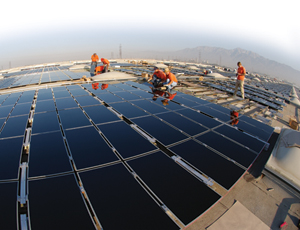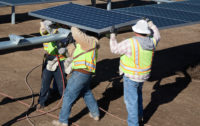If you’re not in the electricity business today, you may be soon. Developments in generation technologies, regulatory policies, industry standards and digital communication are blurring the distinction between customers and utilities. Renewable-energy generation, primarily solar photovoltaic panels installed on privately owned rooftops throughout the country, is serving load under the roofs, with surplus power being sold into the grid. Utilities also are leasing rooftop real estate on warehouses and big-box stores to site their own PV panels.
Throw in building-integrated solar and wind, fuel cells, plug-in hybrids with net metering and a dog’s breakfast of other generation to round out the picture: Customers and utilities are selling power to each other, with generating plants spread like chocolate drops around the landscape, linked by the slowly extending tentacles of the smart grid. The whole country is becoming a virtual powerplant. Call it the Generation Nation.
At the dawn of the decade, electric-industry restructuring in the U.S. had opened the door for competition, and a parade of distributed-generation (DG) technologies marched through to market. Offerings ranged from reciprocating-engine generator sets for standby emergency power to small gas turbines, wind turbines, solar PV, microturbines and a variety of fuel cells, some commercially available, others in an “early emerging” stage.
There was a lot of excitement then. “Deregulation was going to create a more open power market,” says Dennis Scanlon, senior project manager in Stanley Consultants Inc.’s Denver office. But too many failed to include operation and maintenance costs and fuel costs in their calculations and encountered other difficulties. “If it were easy to be a utility, everyone would be,” Scanlon says, adding, “We saw some manipulation of the fuel and commodities market,” and deregulation ground to a halt.
“Now we’re seeing [DG] for other reasons,” Scanlon says. Overall emission characteristics are better for many DG technologies than for central-station fuels. Combined heat and power (CHP), or cogeneration, is more efficient than power generation alone. And distributed generation as an investment can be profitable, improving reliability and power quality while allowing continued operation of a facility during power outages, he notes.
Adoption of distributed generation has been slowed by high prices for natural gas, a principal CHP fuel, says Dan Rastler, manager of the distributed energy resources program at the Electric Power Research Institute, Palo Alto, Calif. State programs to reduce greenhouse-gas emissions could counterbalance that, he notes. Fuel cells can operate on natural gas but also on renewables such as methane from landfills and anaerobic digesters, and they can have high efficiencies in combined cycle. But the most active DG applications are based on renewable fuels, and the photovoltaics market is growing rapidly, with costs falling, he says.
Distributed generation using renewable energy grew 76% worldwide between 2007 and 2008, to nearly $30 billion, reported Pike Research LLC, Boulder, Colo., in March. The clean-tech market-research firm forecasts global revenue of $60.6 billion by 2013. “Solar represents about 98% of the world market, with small wind power and stationary fuel cells each accounting for about 1%,” says Pike analyst David Link. He expects the ratio to remain constant for five years.
Today, solar photovoltaic is “the one type of distributed generation that we’re seeing go in,” says Kiah Harris, principal at Burns & McDonnell, Kansas City. The firm is talking to big-box stores about projects to put PV panels on their roofs.
Close to Parity
“PV costs are coming down,” and now are in the $3,000-per-installed-kilowatt range, Harris explains. With incentives such as the investment tax credits, “they’re approaching grid parity. I wouldn’t say it’s there yet, but it’s certainly better than one to two years ago,” he adds.
Average PV costs per installed watt “declined substantially” from 1998 to 2007, according to a study published in February by Lawrence Berkeley National Laboratory, Berkeley, Calif. Costs fell from $10.50 per watt in 1998 to $7.60 per watt in 2007, in real 2007 dollars, with small installations showing the greatest decline. The declines suggest “state and local PV deployment programs…have been at least somewhat successful in spurring cost reductions,” the authors say.
“Although average installed costs remained flat from 2005-2007, recent developments portend a potentially dramatic shift over the next few years in the customer-economics of PV,” due to an anticipated oversupply of PV modules...














Post a comment to this article
Report Abusive Comment